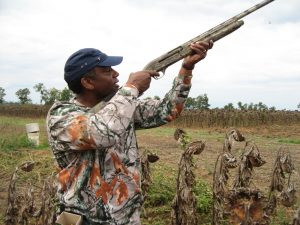
Photo: Kentucky Department Fish And Wildlife
Dove season opens on its traditional day of Sept. 1, and dove hunters need to know about some new rules regarding the use of public dove fields before hunting this year.
“New for this year, there is no access to public dove fields from Aug. 15 to Sept.1,” said Wes Little, migratory bird biologist for the Kentucky Department of Fish and Wildlife Resources. “People can scout from the parking lot or road, but you cannot physically walk into the field.”
Little explained hunters repeatedly scouting fields before the season disturbs the doves and makes them more prone to stop using the field.
“The week prior to the season, we see many groups of hunters scouting the fields, and they unintentionally flush birds,” he said. “The more times you flush a dove, the less likely it is to come back to that field. We want to lessen some of that pressure before the season to ensure a quality hunt.”
There are two new public dove fields this year in Ballard and Butler counties. Hunters using the public dove fields at Curtis Gates Lloyd Wildlife Management Area (WMA) in Grant County must know the shooting hours on opening day (Sept. 1) begin at 2 p.m.
Hunters using the cooperator dove field in Madison County off KY 627 must use U.S. Fish and Wildlife Service approved non-toxic shot.
Little noted that a few of the fields slated for public access failed due to the amount of rain this past spring.
A list of current dove fields is available by consulting the 2019-2020 Kentucky Hunting Guide for Dove, Early Waterfowl, Woodcock, Snipe and Crow. The guide, which is available online only, is accessible on Kentucky Fish and Wildlife’s website. Go to fw.ky.gov and search under the keyword, “dove,” for rules, regulations and additional information.
Hunters can also use the interactive dove field map to find public dove fields on the Kentucky Fish and Wildlife website by searching under the keywords, “Public Dove Fields.”
Hunters using public fields should remember that they cannot clean their birds at the site. Hunters also must pick up all spent shotshell hulls or other trash and obey all signs.
The first segment of the 2019-2020 dove season opens Sept. 1 and closes Oct. 26. The second segment opens Nov. 28 and closes Dec. 8, while the third segment of dove season opens Dec. 21, 2019 and closes Jan. 12, 2020.
In addition to a valid Kentucky hunting license, dove hunters must possess a Kentucky Migratory Game Bird/Waterfowl Hunting Permit. Shotguns must be plugged to only hold three shells total, one in the chamber and two in the magazine.
If not completed already, dove hunters must go online at the Kentucky Fish and Wildlife website at fw.ky.gov and click the “My Profile” tab to fill out the Harvest Information Program (HIP) survey before hunting.
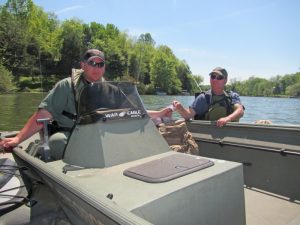
Photo: Kentucky Department Fish and Wildlife
The sun sets earlier each day and the kids are back in school. Summer is all but over. This inevitability prompts many to visit lakes, rivers and streams to get in that last weekend of the summer boating season during the Labor Day holiday weekend.
“Our busiest weekend of the year,” said Maj. Shane Carrier, assistant director of law enforcement for the Kentucky Department of Fish and Wildlife Resources. “Traditionally, Labor Day marks the end of the boating season.”
The crowded conditions common on this holiday weekend make observance of simple boating safety procedures vital to a safe weekend for everyone.
The law requires each passenger in a vessel to have a personal floatation device, commonly called a lifejacket, readily accessible for use. “I cannot stress enough the importance of wearing a lifejacket,” Carrier said. He explained that a lifejacket stored in a compartment or stuffed under a seat is not readily accessible.
“You must be able to get to the lifejacket quickly when you need it,” Carrier said.
Sales of paddlecraft such as kayaks, canoes and stand up paddleboards are booming, but wearing a lifejacket while paddling is of paramount importance for safety.
“Paddlecraft use is growing by leaps and bounds across Kentucky,” Carrier said. “Many paddlecraft users overlook the safety aspect. Paddlecraft are slow and do not have a motor. This lulls people into a false sense of security. I strongly suggest wearing a lifejacket at all times when operating a paddlecraft.”
Carrier said he sees many stand up paddleboard operators with their lifejacket strapped to the front of the paddleboard. “That doesn’t work well if you fall over and hit your head,” he said.
Paddlecraft now line the front of sporting goods, department and hardware stores awaiting a buyer.
“People buy paddlecraft with no training or experience and get in over their head, especially in moving water,” Carrier said. “Leave a float plan with a loved one and get a dry bag to store a charged cell phone on your boat in case you get in trouble.”
Carrier said the law enforcement division spent many hours this year on search and rescue efforts to look for paddlers. “We’ve had quite a few misjudge their take out or how long it takes to paddle there,” he said. “They must know how long it takes to get the float completed. If there is low water and you have to drag a boat over riffles and shoals, it takes time.”
Avoiding alcoholic drinks is one of the smartest safety decisions boaters can make. “Drinking in public is against the law in Kentucky and our waterways are public places,” Carrier said.
The combination of hours in the sun, heat and movement of the boat can induce a mild stupor called boater’s fatigue. “Alcohol intensifies boater’s fatigue,” Carrier said. “This condition can lead to poor decisions on the water.”
Carrier stressed the importance of checking safety equipment to ensure it is in good working order.
A boat with a motor must have a working fire extinguisher on board at all times. “Store the fire extinguisher away from the engine,” Carrier said. “On some boats with inboard-outboard motors, the fire extinguisher is mounted in the engine compartment. If you have a fire, you will burn yourself trying to get to it.”
All vessels over 16 feet in length must have a hand, mouth or power-operated signaling device such as a loud whistle or boat horn. They must also have working red and green navigation lights in the bow of the vessel and a steady white light visible from 360 degrees in the stern.
Boat operators must display these lights from sunset to sunrise in areas where other boats navigate, whether the boat is under power or anchored.
Some boaters mistakenly believe you do not need working navigation lights if you only operate the boat during daylight hours. Mechanical failures, dead batteries or getting lost can prevent a boat from getting back to the dock or ramp before nightfall when you must display these lights. Therefore, lights must be in working condition no matter when you operate the boat.
“You need a light at night so you don’t get run over by another boat,” Carrier said.
Each vessel must have a Type IV throwable personal floatation device such as a float cushion or ring readily accessible for use.
“Although this isn’t boating related, we’ve had multiple people this year drown from swimming,” Carrier said. “People, especially teenagers, try to swim beyond their ability and misjudge the distance. Peer pressure can induce them to try to swim across a large cove and then it is too late.”
Obey these simple safeguards and make the Labor Day weekend memorable for the right reasons.
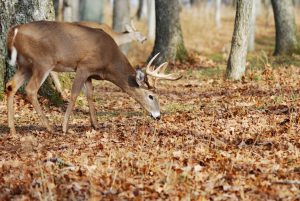
Photo: Kevin Kelly/Kentucky Department Fish and Wildlife
A white-tailed deer from western Kentucky is the state’s first confirmed case of hemorrhagic disease this year.
Murray State University’s Breathitt Veterinary Center recently confirmed to the Kentucky Department of Fish and Wildlife Resources that a deceased female deer recovered from Graves County tested positive for hemorrhagic disease, sometimes referred to as “blue tongue” or EHD. Kentucky Fish and Wildlife is investigating other possible cases involving 22 deer in 11 counties and expects the number could grow in the coming weeks.
“Hemorrhagic disease cannot be transmitted to people or pets,” said Dr. Christine Casey, state wildlife veterinarian for Kentucky Fish and Wildlife. “It is caused by two different viruses: epizootic hemorrhagic disease virus (EHD) and bluetongue virus. These viruses are transmitted to deer by small biting flies, also called no-see-ums.”
Kentucky experiences localized hemorrhagic disease outbreaks each year. More regionally widespread and statewide outbreaks can occur in cycles of five years or longer. A significant regional outbreak of hemorrhagic disease affected many east Kentucky counties two years ago. Far western Kentucky endured an outbreak in 2012, and the last statewide outbreak occurred in 2007.
Outbreaks of hemorrhagic disease generally last from late summer until the first hard frost of the year kills the virus-carrying flies.
Hemorrhagic disease has been present in the United States for more than 60 years. It is not the same as chronic wasting disease (CWD), an always fatal neurological disease that affects white-tailed deer, elk and other members of the deer family. Chronic wasting disease has never been detected in Kentucky.
One main difference between the diseases is that some deer do survive hemorrhagic disease outbreaks and produce protective antibodies, which can be passed to their young. Protective antibodies are major contributors to herd immunity and one reason why Kentucky sees cyclic outbreaks of hemorrhagic disease, rather than a higher prevalence every year.
In Kentucky and across the Midwest, deer that die from hemorrhagic disease typically die within 24 to 36 hours after being bitten by an infected insect. People often find carcasses of deer that have died from the disease around water, and because they died rapidly these animals can appear well fed or otherwise normal. Sometimes there are several carcasses in one area.
While elk in Appalachian Kentucky also contract hemorrhagic disease from insect bites, they usually show no outward signs of illness and death does not occur.
“Kentucky’s archery deer hunting season opens early next month,” said Gabe Jenkins, deer and elk program coordinator with Kentucky Fish and Wildlife. “The department is asking hunters and others to be on the lookout for sick looking deer.
“Deer with hemorrhagic disease can be more susceptible to other diseases. For that reason, the department always cautions against eating the meat from a deer that doesn’t appear to be healthy.”
Through Aug. 21, Kentucky Fish and Wildlife had received reports of suspected hemorrhagic disease in 22 deer. The reports originated from Anderson, Carroll, Christian, Graves, Greenup, Harrison, Meade, Oldham, Trimble, Scott and Shelby counties. The only confirmed case was the Graves County deer. Kentucky Fish and Wildlife is awaiting test results on others.
People can go online now to report to Kentucky Fish and Wildlife suspected cases of hemorrhagic disease in dead or dying deer. The digital form is available at fw.ky.gov under the “Important Info” tab. It takes only a few minutes to complete but provides important data for estimating the scale of the outbreak and for communicating with the public.
Reports also can be submitted by phone. Kentucky Fish and Wildlife staffs a toll-free number weekdays from 8 a.m. to 4:30 p.m. (Eastern). The number is 1-800-858-1549. In addition to their name and contact information, callers will be asked to provide the following about their observation: county and date, number of deer found, and whether the deer were sick or recently deceased.
Information reported to Kentucky Fish and Wildlife through these channels will help the department create maps so the public can see the extent of the disease’s spread.
For more information about hemorrhagic disease, visit the Kentucky Fish and Wildlife website at fw.ky.gov and search for the phrase, “Hemorrhagic Disease.”
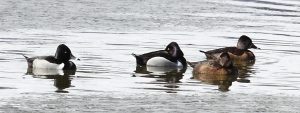
Photo: Kentucky Department Fish And Wildlife
The first snippets of snow fell this week, making most people frown, but put a smile on the faces of Kentucky waterfowl hunters. The cold weather the week before the waterfowl season opener on Thanksgiving Day is a good sign.
“Waterfowl hunting in Kentucky is nearly 100 percent weather dependent,” said Wes Little, migratory bird biologist for the Kentucky Department of Fish and Wildlife Resources. “We will have more birds to hunt if we get cold weather to the north of Kentucky. If we continue with this cold weather, we should have a good opener.”
Little said fantastic habitat conditions for waterfowl await those birds. “The moist soil vegetation such as wild ryes, annual smartweeds, millets and sedges are looking great across the state. The habitat is here and population wise, we are living the glory days.”
A slight dip in duck numbers in 2018 resulting from adverse weather conditions during breeding season in the prairie-pothole region on the northern Great Plains and Canada in 2017 should not concern waterfowl hunters. “We are still well above the long term average for duck numbers,” Little said. “This trend is basically a blip and should not impact hunting at all.”
New public waterfowl hunting opportunities on Sloughs Wildlife Management Area (WMA) in Henderson and Union counties offer a chance for excellent hunting each week of the season. Little explained hunters who have not put in for a quota hunt on the area may try for a minimum of 10 slots via a weekly draw each Monday night of the season.
“Nine of those slots are on the Jenny Hole Unit with one on the Sauerheber Unit,” Little explained. “More slots may be available if those drawn for quota hunts on the area don’t check in on the Sunday before their hunts.”
Waterfowl hunters on Ballard WMA in Ballard County, an anchor of Kentucky waterfowl hunting for decades, no longer have to hunt from blinds. “For the first time, a few boat-in hunting spots are available on Ballard WMA,” Little said. “There are many wade and shoot opportunities as well.”
Boatwright WMA, also in Ballard County, and Doug Travis WMA in Carlisle and Hickman counties, offer daily walk-in waterfowl hunting. For more information on these opportunities, refer to the 2018-2019 Kentucky Waterfowl Hunting Guide available in a printable PDF format at the Kentucky Fish and Wildlife webpage at www.fw.ky.gov. There is no longer a paper version of this guide.
Little said Cedar Creek Lake in Lincoln County, Barren River Lake in Allen and Barren counties and Green River Lake in Adair and Taylor counties offer some of the best waterfowl hunting in the central Kentucky region. He also recommended Cave Run Lake for duck hunting in east Kentucky, especially later in the season. Goose hunting is not permitted on most of Cave Run Lake. The Ohio River also offers good later season duck and goose hunting.
Hunters without a boat and other gear needed to hunt large bodies of water should try farm ponds. “Farm ponds always provide opportunity,” Little said. “You must get permission from the landowner. Do not be afraid to ask, many landowners with resident goose issues are open to waterfowl hunters. Do not forget to close the gate behind you; that is the number one way to lose hunting permission on a farm.”
Steel shotshells in No. 2 through No. 4 work well for ducks while those in BB through No. 2 make good goose loads. “The modern non-toxic loads with tungsten or bismuth allow hunters to use smaller shot sizes,” Little said.
“I mostly use 3-inch, steel shotshells with 1 1-4 ounces of shot for waterfowl hunting,” Little said. Waterfowl hunters may not use or possess lead shot while hunting.
Duck, coot and merganser season opens Thanksgiving Day, Nov. 22 and closes Nov. 25. This season opens again Dec. 3 and closes Jan. 27, 2019. Goose season also opens Thanksgiving Day, Nov. 22 and closes Feb. 15, 2019.
As a reminder, waterfowl hunters must complete a short survey and get their Harvest Information Program (H.I.P.) confirmation number before hunting. Visit the Kentucky Fish and Wildlife homepage at www.fw.ky.gov and click on the “My Profile” tab to begin. The process takes less than 5 minutes.
In addition to the H.I.P. confirmation number, waterfowl hunters need a valid Kentucky hunting license as well as a Kentucky Migratory Bird – Waterfowl Hunting Permit along with a signed Federal Duck Stamp to be legal waterfowl hunters.
Waterfowl hunting provides a fun reason to get outside in winter while providing excellent tasting, nutritious table fare. A meal featuring properly cooked duck is as good as any expensive restaurant
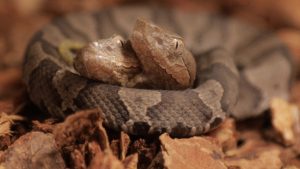
Photo: Kentucky Department Fish And Wildlife
Less than two weeks remain to see a rare, two-headed copperhead snake before the Salato Wildlife Education Center in Frankfort closes for the winter.
The unique, month-old copperhead is on display from 10 a.m. to 4 p.m. every Tuesday through Saturday. Time to view the snake is limited, however, as the Salato Center closes for the season after Nov. 21. Salato will reopen March 1, 2019.
The Salato Center closes seasonally each year to allow the staff to maintain and update exhibits and facilities. This helps ensure a quality experience for the 50,000 visitors who come to the center each year.
During this year’s closure, center staff plan to expand the existing indoor snake exhibit, among other projects. Work to clear hiking trails blocked by fallen trees is planned during this time. Staff closed trails through Davison Woods in the fall, due to the number of trees felled by a severe storm.
Fans of the Salato Center can see what’s going on behind the scenes during the winter closure by following the Salato Facebook or Salato Twitter page.
The Kentucky Department of Fish and Wildlife Resources operates the Salato Center to educate and inform the public about wildlife and conservation. The center is located off U.S. 60 in Frankfort, approximately 1½ miles west of the U.S. 127 intersection. A bronze deer statue marks the entrance of the main Kentucky Fish and Wildlife campus.
Hours are 9 a.m. to 5 p.m. Tuesday through Friday, and 10 a.m. to 5 p.m. Saturday. Salato is closed on Sunday, Monday and state holidays.
Admission is $5 for adults and $3 for youth 5 to 18. Children 4 and under are admitted free. The center also offers annual memberships for individuals and families.
In honor of Veteran’s Day, all veterans and active military personnel with valid identification will be admitted free on Saturday, Nov. 10.
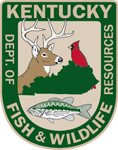 Online applications are being taken through Nov. 15 for youth and mobility-impaired waterfowl quota hunts at two state-owned fish hatcheries near Frankfort and Morehead. Hunts will be available on each Saturday and Sunday in January 2019.
Online applications are being taken through Nov. 15 for youth and mobility-impaired waterfowl quota hunts at two state-owned fish hatcheries near Frankfort and Morehead. Hunts will be available on each Saturday and Sunday in January 2019.
Hunts are being held at the Minor Clark Fish Hatchery in Rowan County and the Pete Pfeiffer Fish Hatchery in Franklin County.
“There are five blinds at Minor Clark Hatchery and two blinds at Pete Pfeiffer,” said Wes Little, migratory bird biologist for the Kentucky Department of Fish and Wildlife Resources. “Drawn hunters must provide their own decoys, put them out and retrieve their own birds.”
Interested youth or mobility-impaired waterfowl hunters may apply online by clicking this link or going to the Kentucky Fish and Wildlife homepage at fw.ky.gov and clicking on the “Hunt” tab, followed by “Quota Hunts” tab. Applications must be submitted by Nov. 15.
Hunt dates in 2019 include Jan 5-6, Jan. 12-13, Jan. 19-20 and Jan. 26-27. Youths under age 16 may apply for these quota hunts. A mentor age 18 or older must accompany the youth hunter. A mentor and youth drawn for a hunt may invite two additional youth hunters or one youth and second mentor to hunt with them. Selected mobility-impaired hunters may only have one assistant in the blind with them.
Drawn hunters will receive a quota hunt permit in the mail in late November notifying the hunter the dates for which they were drawn, along with detailed maps and other instructions concerning the hunt.
If not completed already, waterfowl hunters must go online at the Kentucky Fish and Wildlife website at fw.ky.gov and fill out the Harvest Information Program (HIP) survey before they are legal waterfowl hunters.
 The Kentucky Department of Fish and Wildlife Resources will conduct its fall public auction of surplus and confiscated items Oct. 29 at department headquarters in Frankfort.
The Kentucky Department of Fish and Wildlife Resources will conduct its fall public auction of surplus and confiscated items Oct. 29 at department headquarters in Frankfort.
Surplus auction items include Triton and Polarcraft boats, Yamaha, Johnson and Evinrude boat motors, four-wheel-drive Chevy, Ford and Dodge trucks, Yamaha and Honda ATVs, side scan sonar units, office equipment, air condition window units, GE washer and dryer, a generator and more. Bidding on surplus items is open to everyone.
Confiscated auction items include shotguns, rifles, pistols, bows, hunting equipment and more. Firearm brands being offered for sale include Browning, Remington, Benelli, Ruger, Winchester, Marlin, Rossi and more. Under state law, only qualified Kentucky residents may bid on confiscated items.
A list of all items to be offered at auction is available online at fw.ky.gov, the Kentucky Fish and Wildlife website. The list also includes the terms and conditions of the auction. All items are sold as is.
Viewing begins at 8 a.m. (Eastern), with bidding to begin at 10 a.m. The auction will be near the Salato Wildlife Education Center, which is on the headquarters campus of Kentucky Fish and Wildlife at 1 Sportsman’s Lane. Visitors may find the headquarters complex off U.S. 60 in Frankfort, approximately 1 ½ miles west of the intersection with U.S. 127. A bronze deer statue marks the entrance.
 Weather
Weather Traffic
Traffic @LouisvilleDispatch
@LouisvilleDispatch @LouisvilleDisp
@LouisvilleDisp Subscribe
Subscribe